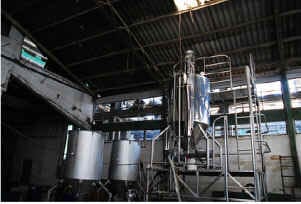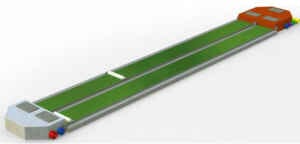A report by Tony Piccolo for FAO Globefish says that although aquatic biofuels my not offer the whole answer, they can produce a solution that does not interfere with the production and costs of food and does not put a strain on food security.
Aquatic biofuels are carbon neutral and producing them has little of no effect on the environment.
"As a society we must slowly move away from our dependency on fossil fuels," Tony Piccolo says.
"We must look at local sustainable and clean alternatives and start producing energy locally.
"This will not only reduce costs but it will also help secure a cleaner environment.
"Fish waste can contribute to securing energy for small to large fishing villages, ships and vessels, and local communities, while ponds or bio-reactors can play a part in securing larger amounts of energy once the economic hurdles are overcome.
"Oil will need to leave the energy market, and we need to start filling the energy gaps with biofuels and other renewable energy resources, like wind, solar, biomass and so on."
In the report Mr Piccolo says that as the world population increases, so will its demand for energy.
"Many scientists fear that greater adaptation of land used to produce crops for biofuels; the greater the loss of habitats will be for animals and wild plants especially in the large rainforest areas of the world," he says.
He says that there are concerns that as biofuels become more lucrative for farmers, crops for food will be substituted with crops for fuel.
He says that this will hit the poor nations that suffer from hunger and depend on humanitarian aid the most. This aid will be threatened by increasing prices and food security could be compromised by the drive to increase the rate of gain in crop yields and food production capacity.
He adds that there are also concerns about the amount of nitrogen oxide being released through intensive farming, because to farm biofuels efficiently at the present time means using fertilisers containing nitrogen.
"The stress on land-use and food security to produce biofuels is becoming quite significant and will be even more so in years to come. Therefore looking at aquatic resources for energy production makes not only ecological sense but economic sense too," he says.
Mr Piccolo outlines two aquatic alternatives for producing biofuels - the extraction of oil for biofuels from micro algae and oil for biofuels from fish gut or fish waste.
He said that although the technology is still at an experimental stage, there is good potential for the two technologies and research is being carried out to explore sustainable ways of producing and harvesting the greatest amount of oil from both micro algae and fish waste.
The technology using fish waste if not new but has only recently started to be exploited.
The technology involves extracting the oils from the waste products after the fish have been filleted. The waste material is mixed with methanol and other products and 1 kg of fish guts will produce about 12 litre of biodiesel.

Picture courtesy FAO Globefish
At present there are two major companies exploiting the technology - Aquafinca in Honduras, which is producing about 11,000 litres of biodiesel a day from its tilapia production and Agifish in Viet Nam, producing 30,000 tonnes of fuel a year from the waste products for catfish production.
The production of the biodiesel starts with the pressing of the fish waste, oil is extracted through a water separation process at 90° C, it is then mixed with methanol (roughly nine per cent) and caustic soda, in order to separate the glycerine from the biodiesel.
The fuel is then purified by adding manganese (a naturally occurring element in nature) and is then fit for engines. The by-product glycerine is sold to the cosmetic industry for the production of soap and the residues are made into fishmeal.
Mr Piccolo says that the technology is easily adaptable and can be used in many poorer regions of the world. He added that with consumption of tra and basa in the Mekong Delta region reaching 400,000 tonnes a year, there is about 50,000 tonnes of fish waste that could be used for fuel.
"With little investment in already existing fish farms local energy can be produced at very little cost," Mr Piccolo's report says.
"Biodiesel from fish residue/waste could also promote more efficient utilization of aquatic living resources and generate additional income for fishers' and fish farmers' communities."
The oil in micro algae, Mr Piccolo says, is very similar to vegetable oil, which makes it highly suitable for the production of fuel.
The main advantages with producing micro algae for energy production are:
- Does not compete with agriculture
- High per acre yield
- Contains no sulphur therefore no SO2 emissions
- Non toxic and highly biodegradable
- Does not require soil for growth
- Uses as little as 8cm of water per year
- Adaptable anywhere even at great distances from water.
- Industrial emissions of CO2 from power plants, refineries, and other stationary emitters can be productively consumed by micro algae in engineered plants and used to manufacture valuable products, thus making the whole process carbon neutral.
"The yield of oil from micro algae is much higher when compared to agricultural biofuels," says Mr Piccolo.
"For example, for the same amount of land use, micro algae yield 40 times more than rapeseed and 100 times more than soya."

The advantages are not only that algae are rich in oil but they grow rapidly and can be cultivated in either engineered recirculating ponds or bioreactors where the temperature and conditions can be controlled. However, production does not affect fertile land or water that could be used for irrigation.

Picture courtesy FAO Globefish
The process works by converting sunlight into oil through the micro algae.
"Hundreds of species of micro algae are being experimented with, such as Arthrospira platensis (spirulina) which is easy to culture and easy to harvest but does not contain a high oil content and Haematococcus pluvialis (red algae), which is very high in oil yield," says Mr Piccolo.
"With the correct species in place and the right conditions the species can produce oil at near-theoretical limits.
"Micro algae are less than 30 microns in size and their aquatic nature makes them perfect for large scale, highly automated, closed production systems like the photo-bioreactor (PBR). These are systems that are highly tuned to provide the precise conditions for max productivity.
"Algae thrive on CO2 and NO2 (pollutants of power plants) - ant these act as nutrients for the micro algae. These facilities can thus be fed exhaust gases from fossil fuel power plants reducing even more CO2 and NO2 emissions, hence making the whole process carbon neutral."
He adds that the use of micro algae is feasible for large scale plants but the cost of setting up the equipment can be high.
Among the large scale operators are A2BE Carbon Capture, Shell Oil and Marine Institute of Comodoro Rivadavia, and research is being carried out in universities and institutions around the world.
Mr Piccolo concludes: "Whereas the fish gut/waste technology is adaptable to small scale energy production, the micro algae to biofuel technology is more suitable to large scale energy production.
"The technology to extract oil from fish waste or gut is adaptable to almost any aquaculture farm with a medium to high productivity rate. Furthermore there is a possibility that this technology could be adaptable on large fishing trawlers."
Both technologies can contribute to increasing employment and would benefit local communities by not having considerable areas of land used for mono-crop biofuels production.
Further Reading
| - | You can view Tony Piccolo's full report and Power Point presentation by clicking here. |
August 2008

